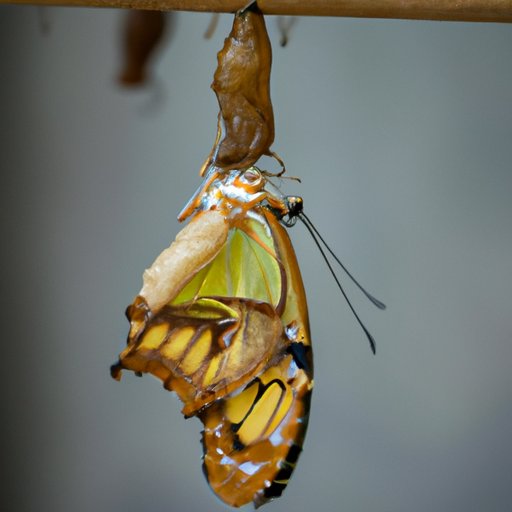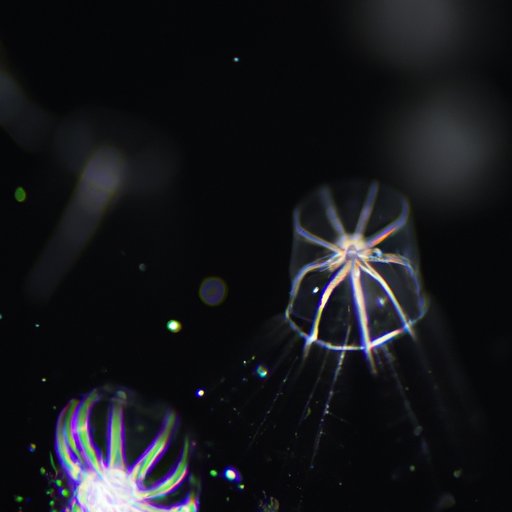I. Introduction
Animal metamorphosis is a remarkable and often strange process of transformation that occurs in the lifecycle of many species. From caterpillars to frogs and sea creatures, metamorphosis can involve a complete change in form, function, behavior, and habitat. Understanding animal metamorphosis is crucial for ecological conservation and offers insight into the power of adaptation and evolution in the natural world.
In this article, we will explore the wonders of animal metamorphosis and delve into the strange and fascinating transformations of some of the most well-known and lesser-known creatures. We will examine their stages of metamorphosis, how they adapt to their environment during transformation, and how we can aid their survival during this critical period. Let’s take a closer look!
II. The Strange Transformations of Caterpillars: A Closer Look at Insect Metamorphosis
The transformation of a caterpillar into a butterfly is perhaps the most well-known example of animal metamorphosis. This process involves four distinct stages, starting with the egg, followed by the larva or caterpillar stage, the pupa or chrysalis stage, and finally, the adult butterfly stage.
During the larva stage, the caterpillar eats constantly and grows rapidly, shedding its skin several times. It forms a protective cocoon or chrysalis during the pupa stage, where it undergoes a complete physical and physiological transformation, breaking down its old body and creating a new one. Finally, it emerges as a fully grown butterfly that can fly, mate, and reproduce.
Adapting to the environment during metamorphosis is crucial for caterpillars’ survival. The toxic chemical compounds produced by some caterpillars’ bodies, such as monarch butterflies, protect them from predators. Simultaneously, other species use camouflage, mimicry, and other protective mechanisms to survive this vulnerable period in their lifecycle.
To aid butterfly survival during metamorphosis, it’s important to provide a suitable environment for their development, such as planting milkweeds for monarch caterpillars or avoiding pesticide use that can harm butterflies’ development.
III. From Tadpole to Frog: Exploring the Wonders of Amphibian Metamorphosis
Amphibians, such as frogs and toads, also undergo remarkable metamorphotic changes in their lifecycle. The transformation of a tadpole into a frog involves three primary stages: egg, larva or tadpole, and adult frog.
During the tadpole stage, the aquatic larvae breathe through gills and swim using a tail. They feed on algae and other small organisms and grow rapidly through several developmental stages. Once they reach full size, they undergo metamorphosis, losing their tails, developing limbs, and breathing through lungs instead of gills.
Adaptation to the environment during metamorphosis is critical for the survival of tadpoles and eventual adult frogs. Many tadpoles have specific habitat requirements, such as low water depths, suitable vegetation, and appropriate food sources. Their adult counterparts require terrestrial habitats that meet their requirements for shelter, moisture, and suitable food.
To aid frog survival during metamorphosis, we can provide suitable habitats for tadpoles and avoid the use of pollutants that can harm their development.

IV. When a Cocoon Becomes a Butterfly: Uncovering the Mysteries of Insect Transformation
Some insects, such as moths and flies, undergo a similar transformational process to butterflies, except that their protective casing is called a cocoon instead of a chrysalis. The transformative process also involves the same four stages: egg, larva, pupa, and adult.
Insect larval stages, such as caterpillars, are often voracious feeders, consuming large amounts of plant material and other insects. As they mature during the pupal stage, they stop eating and undergo startling changes in their physical structure and physiological processes.
Adaptation to the environment during metamorphosis is vital for insect survival and can vary depending on the species. Some species, such as the bagworm moth, build their cocoon using pieces of the host plant, camouflaging themselves and offering them protection. Others, such as mosquitoes, pupate in water to reduce the risk of predators.
To aid the survival of insects during metamorphosis, it’s important to minimize or eliminate the use of pesticides and provide suitable habitats during their developmental stages.
V. The Transformational Journey of a Caterpillar into a Butterfly: A Visual Guide
At this point in the article, you might be wondering what all these stages of metamorphosis look like in real life. Fortunately, there are many excellent visual aids that can help you understand this remarkable natural process more clearly.
Some of the best visual guides to metamorphosis include videos, images, and infographics that offer a step-by-step explanation of caterpillar transformation into a butterfly or moth. National Geographic and the Smithsonian Institute are two excellent sources of visual guides to metamorphosis that can be easily accessed online.
VI. Uncovering the Wonders of Animal Metamorphosis: From Jellyfish to Sea Anemones
While insects and amphibians are some of the most well-known examples of animal metamorphosis, many other species demonstrate equally exciting transformations in their lifecycle. For example, jellyfish undergo a transformational process called “polyp to medusa,” in which they change their physical structure and behavior from being stationary polyps on the seafloor to pulse-driven medusa that can swim and reproduce.
Sea anemones, too, can undergo metamorphosis, especially in response to environmental stressors such as temperature changes or pollution. Some anemones can even change their sex during metamorphosis, becoming females or males depending on their specific needs and circumstances.
Adapting to the environment during metamorphosis is critical for the survival of jellyfish and sea anemones. Many species depend on the right food, temperature, and water quality conditions to undergo a successful transformation. Human activities such as pollution and climate change can have severe impacts on these conditions, leading to disrupted lifecycles and declining populations.
To aid in the survival of jellyfish and sea anemones during metamorphosis, we can support conservation initiatives that aim to protect and preserve their habitats and minimize or eliminate activities that harm their development and survival.
VII. The Hidden Powers of Animal Metamorphosis: How Some Creatures Change Shape Completely
The power of animal metamorphosis is not limited to changing one form into another, but some species can change their shape, function, and behavior completely. For example, certain parasitic wasps have larvae that can transform into “hyperparasitoids,” which are parasitoids of other parasitoids. These transformations enable them to increase their chances of survival and reproduction.
Another example of transformational abilities in the natural world comes from the sea butterfly, a tiny, planktonic creature that can completely dissolve its body and rebuild it using different elements. This process of dissolution and regeneration allows it to adapt to changing environmental conditions and play a vital role in the food chain in the ocean.
These amazing transformations have profound evolutionary significance, demonstrating the adaptability and resilience of species in the natural world. They remind us of the hidden powers of metamorphosis and how exploring them can offer profound insights into the complexity and wonder of life on Earth.
VIII. From Quirky to Beautiful: The Bizarre Yet Fascinating Process of Animal Metamorphosis
From caterpillars shedding their skin to sea anemones changing sex, metamorphosis is full of bizarre and often beautiful changes. Some species of fish, such as the anglerfish, can undergo a sexual transformation where males fuse to females and become a permanent “sexual parasite” on their partner’s body. The sea squirt, on the other hand, starts its life looking like an tiny underwater cucumber, only to transform into a stationary adult that feeds by pumping water through its body.
These transformations can enhance animals’ survival, enabling them to adapt to changing conditions, escape predators or hunt prey more effectively, and find suitable mates. They can also offer us an endless source of fascination and wonder, reminding us of the richness and diversity of nature that surrounds us.
IX. Conclusion
Animal metamorphosis is a remarkable and often mysterious process that offers us an insight into the power and resilience of life on Earth. Through exploring the transformations of insects, amphibians, jellyfish, sea anemones, and other species, we can gain a greater understanding of how they adapt to their environment, survive in the wild, and evolve over time.
However, animal metamorphosis is also vulnerable to human activities such as pollution, habitat loss, and climate change, which can disrupt their lifecycles and threaten their survival. As such, it is crucial that we take action to protect and preserve their habitats, minimize harmful activities, and support conservation initiatives that aim to aid their survival and flourishing.
By understanding the wonders of animal metamorphosis, we can gain a deeper appreciation for the complexity, richness, and beauty of nature, and work towards building a more sustainable and harmonious relationship with it.
